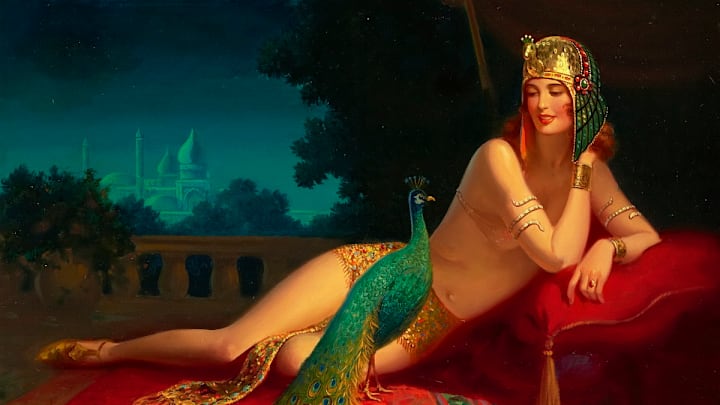Cleopatra, born in 69 BCE as a descendent of the powerful Ptolemaic dynasty, was pharaoh of Egypt when it was under Greek rule. Known in life for her diplomacy (which involved affairs with Julius Caesar and Mark Antony), Cleopatra has achieved legendary status more than two millennia after her death—which, contrary to rumor, may not have been caused by the bite of an asp. Here are a few facts that add to her mystique.
1. Cleopatra was not Egyptian.
She was Macedonian Greek. Her father, Ptolemy XII, was a direct descendant of Ptolemy I Soter, Alexander the Great’s famed general. She was, however, the first person in her family dynasty to speak fluent Egyptian.
2. She ascended to the throne at 17 following the Battle of the Nile.
When their father died, Cleopatra and her younger brother Ptolemy XIII became co-rulers of Egypt. The joint reign did not sit well with either one of them and they immediately began battling for supremacy. Julius Caesar and Roman forces sided with Cleopatra, while Ptolemy XIII and his followers raised an army against them. Cleopatra’s younger half-sister Arsinoë IV marshaled Egyptian forces to turn back the Roman advance. Eventually, Caesar and Cleopatra won the war, Ptolemy XIII was killed, and Arsinoë was exiled to Ephesus in present-day Turkey.
3. Cleopatra had her half-sister killed.
She instructed Mark Antony to have Arsinoë murdered so she couldn’t threaten Cleo’s status and power. That’s pretty cold.
4. Cleopatra was probably not a ravishing beauty.
Romantic descriptions of Cleopatra picture her as an irresistible goddess, but most contemporary accounts say that she had a longish nose and rather masculine features. Her charm, wit, and intelligence more than compensated for her lack of classical features, though. Hollywood films probably went further toward establishing the pharaoh as a jaw-dropping beauty than anything else.
5. Cleopatra allegedly spent 10 million sesterces on a single dinner.
For reference, half a sesterce (a type of Roman coin) could buy a loaf of bread. The dinner story—which is probably just a story—goes like this: Cleopatra playfully bet Antony that she could spend the astronomical amount on a meal. He couldn’t fathom any food that would cost so much and agreed to the bet. The joke was on him when the second course, a cup of vinegar, was served. Cleo removed one of her pearl earrings, dropped it into the vinegar, where it dissolved, and then drank the whole concoction. (It’s probably a myth because vinegar is usually not strong enough to dissolve whole pearls.)
6. Not surprisingly, Cleopatra was exceedingly rich.
She makes Elon Musk look average. Cleopatra had so much money, riches, and assets that when Rome conquered Egypt in 30 BCE, her fortune was enough for Rome to be able to decrease its interest rate from 12 to 4 percent.
7. Cleopatra’s familiar style is pure Hollywood.
Many modern-day depictions of the pharaoh show a glamorous woman with smooth, straight black hair and bangs. A more historically accurate description of her ‘do would be a wig of long, tight curls and no bangs. The be-banged look can be traced to the 1934 film Cleopatra, starring Claudette Colbert, who had a signature hairstyle that included bangs. Her appearance may have influenced Elizabeth Taylor’s portrayal of the queen in the 1963 epic Cleopatra.
8. The real Cleopatra would have approved of Elizabeth Taylor’s wardrobe in the film.
The budget for her 65 costumes in Cleopatra was nearly $200,000, an unheard-of amount for the time. One dress was even made from 24-carat gold cloth.
9. She didn’t do herself in because of Mark Antony.
Strabo, a Greek historian who was alive when the Cleopatra died by suicide, suggests that her cause of death have been a toxic ointment, not an asp bite. Other accounts written within 10 years of her death say a pair of asps bit her. But one aspect is almost certain: She didn't do it because she was heartbroken over the death of Antony, a trope played out in dozens of modern movies and novels. Her reasoning was likely related to Egypt’s fall to Rome and her impending march through Rome as a conquered opponent. One more myth to debunk: It’s doubtful that the asp(s) bit her on her breast. Prior to Shakespeare romanticizing the event, all accounts reported that she was bitten on the arm.
10. Cleopatra’s burial place is a mystery.
According to the Greek writer Plutarch, Cleopatra was buried with Mark Antony somewhere in Egypt. There’s also some evidence to suggest she had a tomb built for herself in Alexandria, and that it now sits submerged in the Mediterranean. Archaeologists excavating the Taposiris Magna temple near Alexandria have found evidence that could suggest Cleopatra (and perhaps Antony, too) were buried at the site, but more research is needed.
A version of this story ran in 2010; it has been updated for 2022.
